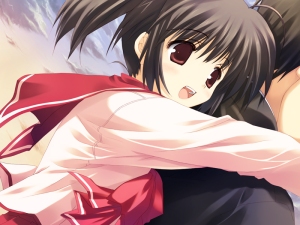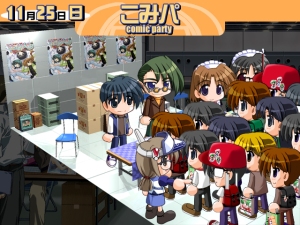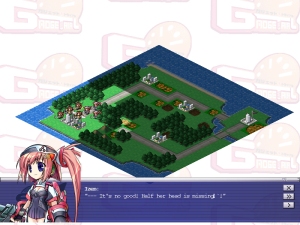The bishoujo* confusion
* Translators note: “bishoujo” means pretty girl.
So, I just had a little commenting back and forth going on with Walter, a guy who takes his Fire Emblem very seriously. If you do have even a passing interest in the series, his blog seems like a good place to stop by.
Right, so, what activated this discussion was that Walter addressed Tokimeki Memorial as a visual novel. And I reacted to that – thought that didn’t feel quite right. But, you know, during this short comment box conversation it struck me that the different genres in which all these pretty girl games belong to, they sort of blur together. Genres are mixed with each other, and because these games are primarily still in Japanese, and really only can be looked on as a niche interest for some of us, there’s probably a fair bit of confusion going on.
So basically, instead of derailing that comment field even further, I thought I’d just try and get my thoughts out there and how to tell genres apart…etc!
This might turn into another long post, so be prepared going in 🙂
——————————————–
Let me just start off by dropping some words:
Galge, bishoujo game, visual novel, (adult) adventure game, dating simulation, digital comic and eroge.
(This will work wonders on my search statistics! 😀 )
These are the genres I could think if from the top of my head. Clearly, that’s a fair number. The problem with these are that, these genres manifest themselves not so much visually, as they do through actual gameplay – or lack thereof. So when just having a quick look at games from these different genres, they will probably look pretty samey. They do use the same kind of visual cues, using a similar interface and just generally have a nearly identical presentation.
To see how the games differs, one must observe the actual mechanics of play used in these different genres.
And before I begin, please note that I’m not an expert either – just have a very strong idea of what I think is right here so feel free to call me out 🙂
Visual Novel
I want to start with separating the visual novel from the rest of the bunch, as it’s both popular right now and I think it’s possible people might use it as an umbrella term for all the others.
Visual novels, or “VNs” seem to have gained a fair bit of following in the west – Katawa Shoujo, anyone? Also, games from developer KEY comes to mind (Air, Clannad, Kanon) as they have received popular anime adaptions courtesy of studio Kyoto Animation, and thus been able to reach out more than most VNs that just stay in Japan.
To me, a visual novel is just that. It’s a branching novel being told through the use of text and visual imagery. A fancy, digital create-your-own-adventure kind of thing.
Usually, or the ones that I’ve played, these games do not offer very much in the form interaction or exploration – instead they’re all about delivering a story. You play this game to experience the story, the characters in it and what they experience throughout their respective story routes.
By making choices when prompted you dictate which way the story will develop. Some choices are obvious, some less so. Playing a visual novel game is about finding the route you seek, learning what choices to avoid and generally just getting lost in the world painted up – getting immersed. In terms of pacing, most VNs I’ve played takes you through a single day at a time, so you can immerse yourself in the life of…whoever you’re supposed to be.
Examples: Fortune Arterial, every game from Key, Gift, ToHeart 2, Katawa Shoujo, and many many more.
Adventure & Digital comics
This is such a broad term. And it’s not to be confused with old Lucas Arts games either 😛
The “adventure” game might look like a visual novel, and it too might have a pretty heavy emphasis on storytelling. The difference is how they go about delivering this to you.
Contrary to the visual novel, where the idea is immersion through following a story and then dictate where it goes, adventure is about immersion through the interaction and exploring of the game world. The story will proceed once the player has met certain criteria or taken certain actions.
How this goes about is that, as you’d expect, you have choice of where to go, who to talk about and about what. What item you want to use to solve a problem etc.
To my understanding, adventure games and dating sims, which are similar but still different, were more common a number of years back and today seem to have been almost completely replaced by visual novels. Are they just easier to make, or what? 😛
Examples: EVE-series, Snatcher, Policenauts, Doukyuusei.
Now, similar to adventure games, but much more straight forward, are the digital comics. They can be a lot more linear and as a result easier to go through. Think of them as a light adventure game.
Examples: Galaxy Fraulein Yuna, Urusei Yatsura * Stay with you, RANMA 1/2 Toraware no Hanayome.
Simulation
This is an interesting one. It might still contain traces of both the visual novel and adventure game, but the focus seems to be on managing. Managing what? Parameters, most often.
Exactly what you’ll be doing can differ though. Sometimes you’re just managing your daily day to day life, other times you’re tasked with managing a group of people – there are a number of different “sims” out there. Dating sims and raising sims, to name two popular ones.
For example, a dating simulation would be about getting to know girls, then date them with the goal of entering a relationship. These girls might be attracted to different attributes which you can improve as the game progresses. A raising sim on the other hand, is about managing another person. For example, the Graduation games are about helping a number of students with different personalities and strengths/weaknesses graduate.
In another game you’re handed with the task overseeing a group of idols and making sure they get popular. Or maybe train a fighter. There are lots of variations on this.
Interestingly enough, even though the focus is on gameplay rather than storytelling – some of these aren’t so empty on story as one would think.
Examples: Tokimeki Memorial, Graduation, The IDOLM@STER, Princess Maker, Pia Carrot, Comic Party.
The others
There are other genres too of course, such as strategy RPGs and simulation RPGs and so on, which borrow the same visual presentation as these do. In fact, the visual novel way of story telling is a very easy and effective way of both introducing characters and progressing a story with limited resources have therefore seen widespread use.
For example, a tactical strategy game could contain visual novel-style story telling and let units gain experience points in an RPG like fashion. They could also feature different amount of adult content and thus complicate things further. Which brings me to…!
Adult content
What about galge & eroge? Galge is short for “gal game” and I lump that together with the bishoujo game (pretty girl game) genre. I suppose as long as a game contains pretty girls as it’s main theme it can be considered a galge/bishoujo game. It’s like a very broad generalisation of all games discussed here.
Eroge, erotic game, means that the game features erotic content as a major theme – and to my knowledge doesn’t say anything exactly about actual gameplay mechanics, just that it will feature such content. In essence, there’s an important difference between an eroge and a game which features erotic scenes in it’s narrative context. Anyone that has ever tried to play a visual novel for it’s adult content probably knows what I mean – it can take AGES before you get to see anything 😀
Actually, on the topic of adult content, there seems to be common notion on the internet that most, if not all, galge/pretty girl games are porn. Well, they are not and the easiest way to tell if a game has adult content or not, is to see for which platform or system was this game released.
Generally, console releases are free from or feature very little in the case of such material. Some games are more risqué than others (i.e. fanservice) but you should not be seeing any direct, full on pr0n in any major console release. Except for the NEC PC-FX library which totally got that going on. But the PC-FX wanted to be like a PC, and that’s where you’ll find it. If a game has a PC release, it’s pretty safe to assume – even if a console version of the same title exists and doesn’t – that it will have adult content.
What usually happens is a game is released on the PC and it features adult scenes and material. Later said game gets ported to a popular game console and, in line with the restrictions or wishes from the company behind the console, the potentially “offensive material” is removed. Often a new character or route is added to make this version seem interesting still.
This is what normally happens with popular PC titles when ported to consoles. For example, Comic Party was first released for PC and it featured adult scenes with the heroine of your choice at the end of her story progression. Comic Party was then ported to the Dreamcast, dubbed Comic Party DCE or “Dreamcast edition”. Now, the endings were changed and the porn removed. A new character, Subaru, was also added. Later on, this version, Comic Party DCE was brought back to the PC, again sans porn.
However, sometimes, things happens the other way around. Popular visual novel ToHeart 2 was released to much acclaim on the Playstation 2. When it later got a PC port, however, they added erotic content to the endings of each character and dubbed it “ToHeart 2 X-Rated”. On top of this, a new character & route was also added.
So it can go both ways, really. The most important thing about this however is that I wouldn’t call ToHeart 2 a straight up eroge – because the porn is not the reoccurring theme – it’s not the point, it’s more of a “reward” because it’s at the utmost end of a characters route. Like, “here’s something for your hard work!”. A carrot, if you will. Now whether this is content you wish to see or not is another question.
So, if a game is all about meeting cute girls in order to proceed on with the mating, it’s an eroge, if it’s a visual novel with some porn in the end, it’s more of like an adult visual novel. See what I’m getting at?
Conclusion
It’s really easy to see why things tend to get confusing after a while – without seeing the game in action long enough to determine just what kind of game it is, it can sometimes be almost impossible to tell them apart 😀
And if you want a modern, popular example of a game which at first can be hard to categorize, what about the Ace Attorney-games? It’s a lawyer simulation with a slight arcade feel, featuring both visual novel style story telling and adventure segments where you look for cues. And if we stretch this quite a bit further…what about James Bond movies? All that I’ve seen (not that many actually) has featured Mr.Bond in bed with at least one lady at some point in time, but the Bond movies are not sold together with the smut on the 18+ shelves. It might feature adult scenes, but it’s not actually about them. It’s like the reverse of why you don’t watch smut for “the plot”.
Anyway, I’ve ranted on long enough – need some breakfast! 🙂












Recent comments